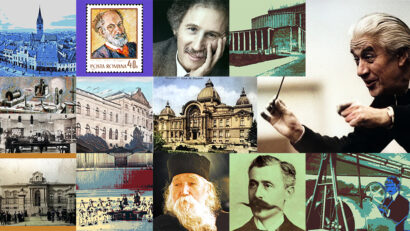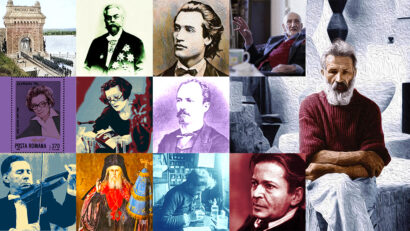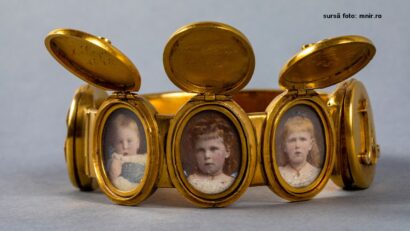The Heroes’ Endless Column
The most famous work of the great sculptor Constantin Brâncuși is the Endless Column

Steliu Lambru, 05.03.2023, 14:00
The most famous work of the great sculptor Constantin Brâncuși is the Endless Column, together with The Gate of the Kiss, The Alley of the Chairs and Table of Silence, which are part of the ensemble located in the city of Târgu Jiu. The impressive 30-meter monument has been given many interpretations. But its strongest significance is that of offering to the fallen heroes of the First World War, between 1916 and 1919. The great artist Brâncuși paid tribute to the sacrifice of those ordinary people through an unparalleled, universal work. Professor Adrian Tudor from the University of Târgu Jiu was one of those who got involved in the restoration and protection of the column in the years 2000.
He will next underline the direct connection between Brâncușis column and those who died for the ideas of the First World War: All the experts, the art critics consider the Endless Column or the Infinite Column as it is also called, the synthesis of creation, the testament of Brâncuși’s creation. The art critic Ion Pogorilovschi said that, viewed from any angle, the column shows us another work by Brâncuși. If we look at the force of a rhomboid, of a module, we see the chest of the Bird in Space. If we look from a different angle, we see part of Brâncuși’s work The Cock, which is another work that Brâncuși wanted to be exhibited in the open air right in Paris, in front of the current UNESCO headquarters. The column from Târgu Jiu is the only one that rises up to the sky in Brâncușis hometown. Brâncuși himself used to say: quote: this was the will of the good Lord, that I should raise the only column at home, in Târgu Jiu. unquote. He had carved in wood before. Other versions of the column, made of wood in his workshop in Paris, are exhibited at the Pompidou Center. Brâncuși had also erected a column near Paris in the yard of a very good friend, about 9 meters high, which was later taken down by Brâncuși himself and brought back to his workshop. We find it now on display at the Pompidou Center.
The history of the column began at the end of the 1930s. The commemoration of two decades since the end of the Great War made Romania receive that unique work. Adrian Tudor recalled the heroic episode of the people of Gorj in 1916 who came up with the idea of the monument: Brâncuși was invited to Târgu Jiu to create a work in honor of the heroes of the Battle of Jiu. October 14 was the day that decided the fate of the war. There are two events that mark the day of October 14th, the most important being the Battle of the Jiu Bridge where the city’s civilians, the elderly, the women and the children who remained in the city and the scouts, under the command of Police Commissioner Popilian, defended the bridge. The Jiu River represented, on its course up to the mountain, a line of defense. Even the newspaper Times later writes about the victory of the Romanians who, on October 14, stopped the entry of the German army into Gorj and, further, into Târgu Jiu. Constantin Brâncuși was invited by Mrs. Aretia Tătărăscu, the wife of the Prime Minister Gheorghe Tătărăscu and the president of the Romanian Women’s League, who had been invited to Târgu Jiu to build a monument. Constantin Brâncuși had been recommended to her by another famous Romanian artist, Mrs. Milița Petrașcu. She left us the mausoleum of Ecaterina Teodoroiu, in Târgu Jiu, where the heroine is buried. Brâncuși accepted but on the condition that he was allowed to freely create a monument that he would like, in honor of the heroes.
And Brâncușis free spirit transforms the idea into matter. Adrian Tudor has more details: In 1937, in the spring, he came to Târgu Jiu together with the engineer Ștefan Georgescu from Gorj county. He visited Târgu Jiu and looked for certain places where the Column could be placed. He chose the current location, which, at that time, was on the outskirts of the city, but later the city developed. It was a place that Brâncuși called the Hay Market. Indeed, a livestock fair was held there, which involved the presence of haystacks. He took a photo of the place and on that photo, he drew the column with a pen. And that gesture was considered the column’s birth certificate. Starting from the idea of the column, the inner pillar was cast in Reșita in 1937. The modules were cast at the factories in Petroșani, the pillar being made of steel and the modules of cast iron. They were brought to Târgu Jiu and the column was assembled in 1937 between October and November.
But during this time Brâncuși had already made the decision to do something much more grandiose, to make a Path of the Heroes that had to express something even grander: the formation of Greater Romania. It was meant to be a work that started from Jiu, from the Table of Silence, The Alley of the Chairs, The Gate of the Kiss with two side benches, the Church of the Holy Apostles, through the altar of which there passed the imaginary axis of the Hero’s Path which ended at the Column. They all form together a so-called ‘road of trials of one kilometer and 300 meters in between two parks. The Endless Column, whose original name was the Column of Endless Gratitude is the culmination of a generation that set right what it believed was wrong and offered it to posterity. (LS)






























